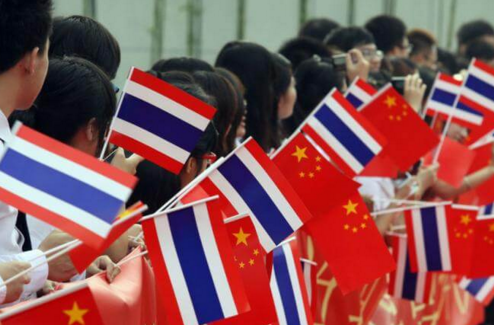
BEIJING, Feb. 6 (Xinhua) -- Located in the center of Indo-China Peninsula and being both the crucial region of the Silk Road Economic Belt and the vital part of the 21st-Century Maritime Silk Road, Thailand has become an important partner to jointly build the Belt and Road.
The Belt and Road Initiative and Thailand’s Eastern Economic Corridor are seeking common interests in development strategy, which injects new impetus into the pragmatic cooperation between China and Thailand.
The Belt and Road Initiative has enhanced the interconnection among the participating countries and regions in fields such as infrastructure and logistics system, hoping Thailand’s Eastern Economic Corridor can integrate with the Belt and Road Initiative, which is expected to bring momentum to Thailand’s economic development, commented Somkid Jatusripitak, Thailand's Deputy Prime Minister in charge of economic affairs recently.
-- Thailand’s development strategy highly consistent with the Belt and Road Initiative philosophy
Thailand will make full efforts to push forward Thailand 4.0 strategy in the coming 20 years, leading Thailand to walk out of the “middle-income trap” and step into the team of developed countries, according to Thai government.
The Eastern Economic Corridor project, one of the essential carriers to achieve this grand strategic goal, aims to devote great energy to develop infrastructure and roll out a host of investment favourable policies to encourage the development of high value-added industries, such as new vehicle, bio-technology, intelligent electronics, medical care, robot and digital industry. Thailand hopes to build the Eastern Economic Corridor into a high-tech industry cluster area.
The economic development strategy proposed by Thailand, with innovation as its main focus, highly matches with the development philosophy and goal of the Belt and Road Initiative.
China and Thailand have reached a consensus that on the basis of the Belt and Road Initiative and Thailand 4.0 strategy, the two countries will intensify bilateral economic and trade cooperation in five major areas, including infrastructure, industrial clusters, electronic information and communication technologies, digital economy, science and technology, and energy in the following five years, which signifies the two countries will reach all-around connection in development strategy and policy ideology.
“Thai government and people will certainly support and attach high attention to the Belt and Road,” commented Somkid. An increasing number of Chinese enterprises are settling in Thailand, which will further bring impetus to Thailand’s industrial structural optimization and economic development enhancement, to help Thailand reach the goal of becoming the regional logistics center, finance center and high-end industry base.
-- China-Thailand railway to become the artery linking the two countries.
According to the plan, Thailand will inject 1.5 trillion baht (one yuan is equivalent to about five baht) in the Eastern Economic Corridor in five years. The main infrastructure projects would include the Bangkok-Rayong high-speed railway, expansion of U-Tapao International Airport and expansion of Laem Chabang deepwater port.
“The Eastern Economic Corridor lies in excellent strategic location, neighboring four countries including Cambodia, Laos, Myanmar and Vietnam, radiating the whole ASEAN, also linking China, Japan, Korea and India, and even farther markets like America and Oceania,” said Uttama, Thai Industry Minister.
Somkid pointed out that balancing economic development mode, developing high value-added economy, enhancing infrastructure construction and building the Eastern Economic Corridor new industrial town are all the policy focuses of the Thai government. Thailand will work closely with the Belt and Road Initiative, especially on the cooperation projects of the Eastern Economic Corridor railway and China-Thailand railway, which will help to develop the Eastern Economic Corridor into a regional logistics center.
Some analysts believe that Thailand 4.0 strategy, the construction of the Eastern Economic Corridor in particular, will offer massive opportunities and platform for the cooperation between Chinese and Thai enterprises in the area of high-end manufacturing. Thailand 4.0 will step forward hand in hand with the Belt and Road Initiative, to lead China-Thailand relations to a new level.
The construction of the first phase of China-Thailand railway project began on December 21, 2017. The infrastructure projects like China-Thailand railway will link the Eastern Economic Corridor with the broad Chinese market, and will help Thailand give full play to its location advantage.
Thailand is expanding the construction of the Eastern Economic Corridor, while China prides itself on advanced technologies in steel, construction industry and manufacturing industries, which can meet the current development needs of Thailand. The cooperation between Thailand and China is a move bringing mutual benefits, said Chen Zhenzhi, chairman of Thai-Chinese Chamber of Commerce.
--China’s advantageous capacity fills the blank of Thailand’s industrial development
Rayong Province, about 100 kilometres southeast to Bangkok, is an important industrial base in Thailand. It lies in the core area of the Eastern Economic Corridor. Thai-Chinese Rayong Industrial Zone in Rayong Province is one of China's first overseas economic and trade cooperation zones as well as China’s first overseas industrial park developed and built in Thailand.
So far, the park has attracted about 100 Chinese enterprises to come and make investment, which has brought total investment of over 2.5 billion U.S. dollars and accumulated sales volume of over 8.0 billion U.S. dollars.
“Our goal is to build the zone into an evergreen industrial park on the Belt and Road, which is to accommodate 300 enterprises in the future,” said Xu Genluo, president of Thai-Chinese Rayong Industrial Realty Development Co., Ltd.
Enterprises from China's traditional advantageous industries, such as auto parts, motorcycle, new energy and new materials, electronic machinery and many others, have entered the Rayong Industrial Zone, filling the blank of Thailand’s industrial development in many fields.
The technologies and funds brought by Chinese enterprises are substantial support to Thailand’s development, said Chokedee Kaewsang, Deputy Secretary General of Thailand Board of Investment. (Edited by Yang Yifan, yangyifan@xinhua.org)




 A single purchase
A single purchase









